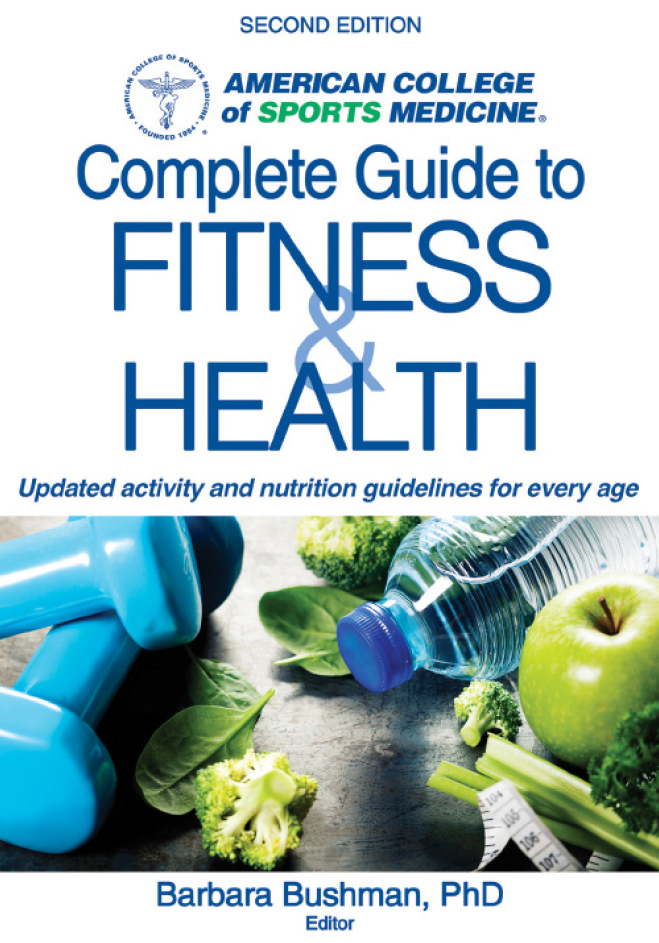ACSM’s Complete Guide to Fitness & Health Book Summary
This comprehensive guide by the American College of Sports Medicine (ACSM) merges scientific research with practical strategies for fitness, nutrition, and wellness across all life stages. Edited by Barbara A. Bushman, it covers exercise programming, disease prevention, age-specific fitness guidelines, and special conditions such as diabetes, cancer, osteoporosis, and more.

Part I: Foundations of Healthy Living
Chapters 1-4 introduce the foundational concepts of physical activity, nutrition, motivation, and behavior change.

- Wellness is multidimensional: Physical, emotional, social, intellectual, spiritual, and occupational health must be balanced.
- Physical activity and diet profoundly affect disease risk, daily function, and quality of life.
- Sedentary lifestyles are linked to obesity, cardiovascular diseases, diabetes, and cancer.
- Behavior change is emphasized, with strategies to overcome barriers, set realistic goals, and sustain long-term healthy habits.
The concept of “Sit Less, Move More” is a central theme, supported by data showing over 10 sedentary hours daily for adults. Incorporating light and moderate activities in everyday life (standing meetings, walking breaks) is encouraged..
Part II: Building a Better You with Exercise
Chapters 5-8 cover the four pillars of a complete exercise program:
- Aerobic Fitness: Activities like walking, cycling, swimming to enhance heart-lung efficiency, reduce disease risks.
- Muscular Fitness: Resistance training improves muscle strength, functional ability, bone density, and metabolic health.
- Flexibility: Stretching routines to maintain joint range of motion, prevent injuries, and manage arthritis.
- Neuromotor Fitness: Functional exercises focusing on balance, coordination, agility, crucial for fall prevention and daily tasks.
The section highlights progression principles, sample workouts, and practical assessments for each fitness component.
Part III: Fitness & Health Across the Lifespan
Chapters 9-11 deliver age-specific recommendations:
- Children & Adolescents (0-17 years): Emphasis on play-based activities, developing lifelong exercise habits.
- Adults (18-64 years): Structured exercise for stress management, chronic disease prevention, and quality of life.
- Older Adults (65+): Focus on maintaining independence, functional ability, and fall prevention through tailored exercise programs.
Each chapter provides sample exercise plans and nutritional guidelines appropriate for the age group.
Part IV: Managing Health Conditions with Fitness & Nutrition
Chapters 12-20 focus on disease-specific strategies:
- Cardiovascular Health: Exercise and DASH diet to manage hypertension, cholesterol, and heart disease risks.
- Diabetes: Physical activity improves insulin sensitivity and glucose control.
- Cancer: Exercise supports treatment recovery, reduces fatigue, and improves quality of life.
- Alzheimer’s, Osteoporosis, Arthritis: Tailored exercise routines for cognitive health, bone density, joint function.
- Weight Management: Behavior-based strategies for sustainable weight control.
- Pregnancy & Postpartum: Safe activity guidelines for mothers.
- Depression: Exercise as an adjunct therapy to alleviate symptoms and improve mood.
Each chapter integrates evidence-based recommendations with practical interventions.
Sleep & Stress: Overlooked Pillars of Health
The guide emphasizes that sleep quality and stress management are integral to overall health. Poor sleep contributes to obesity, cardiovascular disease, and impaired cognitive function. Stress affects nearly every bodily system and is linked to hypertension, heart disease, and mental health issues.
Practical strategies include:
Stress reduction through exercise, mindfulness, and relaxation techniques.
Sleep hygiene practices (consistent sleep schedules, limiting caffeine, optimizing sleep environment).
Practical Tools & Resources
- Fitness self-assessments for aerobic capacity, strength, flexibility, and balance.
- Sample exercise programs for various fitness levels and health conditions.
- Nutritional guidelines based on the 2015-2020 Dietary Guidelines for Americans.
- Visual aids like figures, tables, and charts simplify complex concepts.
- Emphasis on safety, progression, and individualization in exercise prescription.
Review
Highlights
- Comprehensive Content: The book covers a broad spectrum of topics, including physical activity, nutrition, motivation, and wellness across different life stages. It provides step-by-step instructions and full-color photos for effective exercises, sample workouts, and practical advice.
- Age-Specific Guidance: It offers tailored advice for various age groups, from children to older adults, ensuring relevance for readers at different life stages.
- Condition-Specific Strategies: The guide addresses managing health conditions such as diabetes, cardiovascular disease, cancer, depression, osteoporosis, arthritis, pregnancy, and Alzheimer’s disease through exercise and nutrition.
- Behavioral Insights: Chapters on motivation and behavior change provide strategies to help readers initiate and maintain healthy habits. DoctorLib
Reader Feedback
- Positive Reviews: On Goodreads, readers appreciate the book’s thoroughness and practical approach, noting its usefulness for both fitness professionals and individuals seeking to improve their health.
- Professional Endorsements: Experts in the field commend the book for its evidence-based recommendations and comprehensive coverage. For instance, Robert Sallis, MD, FACSM, describes it as “a must-read book for anyone who desires to live a long and healthy life.” Barnes & Noble
Considerations
- Academic Tone: Some readers may find the book’s academic style and detailed information more suited to those with a serious interest in health and fitness, such as students or professionals in the field.
- Depth of Content: While comprehensive, the book’s depth may be overwhelming for readers seeking a quick or casual overview of fitness and health topics.
Conclusion
ACSM’s guide emphasizes lifestyle choices in physical activity and nutrition as key determinants of health. The book introduces readers to a holistic concept of wellness across physical, emotional, social, intellectual, spiritual, and occupational dimensions. Through evidence-based recommendations, it details how a balanced exercise program—aerobic, muscular, flexibility, and neuromotor fitness—improves health outcomes and daily function. The guide underscores the dangers of sedentary lifestyles and promotes the mantra of “sit less, move more.” Specific chapters provide tailored advice for children, adults, and seniors, along with condition-specific strategies for managing heart disease, diabetes, obesity, and mental health. Sleep and stress management are also featured as crucial wellness components. The second edition builds upon the first with updated research, practical tools, and sample programs for lifelong health enhancement.




